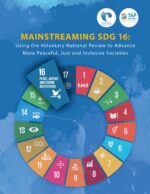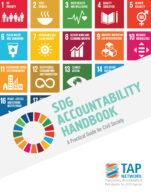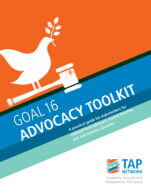Producing and supporting citizen-generated data
Citizen-generated data can offer a more complete and accurate picture of progress (or lack thereof) towards peaceful, just and inclusive societies
Citizen-generated data are “data that people or their organisations produce to directly monitor, demand or drive change on issues that affect them.”1 A form of non-official data,2 citizen-generated data may be quantitative or qualitative and may be produced through a range of means including research, social audits, crowd-sourcing online platforms, mobile phone and SMS surveys, social media, storytelling and community radio. Citizen-generated data include both data produced directly by citizens or CSOs – such as Transparency International’s Global Corruption Barometer3 – and data translated by citizens or CSOs from publicly available (open) data sets – such as Publish What You Fund’s Aid Transparency Index.4
Data generated by citizens and CSOs – especially survey-based perception and experiential data – are important for SDG16+ accountability as they can offer a more complete and accurate picture of progress towards peaceful, just and inclusive societies. They can complement official sources of data, fill gaps in existing data and/or supplement official reporting when the quality, availability or impartiality of official data on SDG16+ is insufficient or questionable. Importantly, citizen-generated data can help to leave no one behind by ensuring that people’s perspectives and experiences – especially marginalized communities and population groups often overlooked by official data collection processes5 – are documented and taken into account in monitoring progress on peace, justice and inclusion.
Despite being more than five years into the implementation of the 2030 Agenda, significant gaps remain in official data on SDG 16 due to methodological issues, limited resources and the limited capacity of national statistical offices (NSOs) to collect data.6 The politically sensitive nature of certain SDG16+ targets may also play a role in dissuading some governments from prioritizing the production of SDG16+ data.7 In light of these and other challenges, citizen-generated data can make a valuable contribution to tracking progress towards peaceful, just and inclusive societies. As long as the methodologies to produce citizen-generated data are as robust and open to public scrutiny as those used to produce official data, citizen-generated data should be considered as valid and credible as official data.


There are a number of ways that you can promote, support and/or produce citizen-generated data on SDG16+ including the following:
Custodian agencies are the United Nations bodies (and in some cases, other international organizations) responsible for compiling and verifying country data and metadata, and for submitting the data, along with regional and global aggregates, to the United Nations Statistics Division (UNSD). For more information, see: United Nations. ‘Roles and responsibilities of SDG monitoring and reporting’. Available at: https://www.sdg6monitoring.org/activities/roles-and-responsibilities/
[/efn_note] – For example, you can urge these stakeholders to include citizen-generated data alongside official data in global, national and local monitoring of and reporting on SDG16+ implementation.a. Providing financial support and other resources to build the capacity of civil society actors and citizens to collect, process and analyze data on SDG16+, including disaggregated data;
b. Working with vulnerable and marginalized groups – especially women, youth, children, Indigenous peoples, people with disabilities, ethnic, linguistic and religious minorities, refugees and migrants, and internally displaced and stateless persons – to engage in SDG16+ data collection and analysis;
c. Documenting and sharing tools, protocols, and other strategies to generate data on SDG16+ with other civil society initiatives;11
d. Adopting a human rights-based approach to SDG16+ data collection (see Box X); and
e. Taking the following factors into consideration in seeking to produce data on SDG16+:
i. Data-gathering methodology – Is the methodology clear and consistent, and does it conform with the basic principles of a human rights-based approach to data?
ii. Types of measurement – What are the types of measurement used and how can they be aligned with SDG data-gathering efforts?
iii. Verification of data – Can the data be adequately verified in accordance with key principles of data validation and verification?
iv. Digital divide – Is there a risk of creating a ‘digital divide’ if the data are generated through internet-based or Information and Communication Technology (ICT) applications?
v. Capacity building – Are there measures in place to ensure adequate data and methodological literacy of those collecting the data?12
A human rights-based approach to data13
In general, all data collection on the SDGs – including SDG16+ – should be guided by the Human Rights-Based Approach to Data (HRBAD) developed by the UN Office of the High Commissioner for Human Rights (OHCHR). The HRBAD guidance highlights the following principles:
Case Study


Case Study
Focusing on Corruption in Rwanda to Assist in Achieving the SDGs
Transparency International
Starting in 2018, Transparency International (TI) Rwanda supported national efforts to produce the country’s 2019 VNR. From the beginning, TI Rwanda was keen to emphasize the linkages between corruption and the SDGs, and so it produced a scoping study on the effect of corruption on national efforts to meet SDGs 1, 3, 4, 5, 8 and 13. While corruption was relatively high on the national agenda, key SDG implementers in line ministries were not sufficiently sensitized to the risks that corruption posed to the country’s targets under the 2030 Agenda. To address this issue, TI developed a comprehensive approach intended to (1) produce evidence that corruption hinders progress towards national development goals; (2) identify innovative mechanisms to mitigate corruption risks in SDG implementation; and (3) track the effectiveness of these measures over time jointly with SDG implementers.
The approach involved producing a one-page “dashboard” that combines both official and non-official data sources for each SDG relevant to TI Rwanda’s work. By consolidating various, scattered datasets into one coherent framework, the dashboard provided a highly actionable roadmap to reduce corruption vulnerabilities in SDG implementation.
So far, TI Rwanda has taken the approach of combining desk research with online expert surveys, followed up by workshops to assess the severity of the risks identified. The organization has found that hosting small multi-stakeholder workshops with expert representatives from government, the private sector and civil society during the process of developing each SDG dashboard has been highly beneficial. This is because involving these partners at an early stage helped to nurture a sense of ownership and buy-in from both government and non-government representatives, which also facilitates the access to the data needed to monitor progress.
When it comes to selecting indicators and data sources, TI Rwanda has found that in addition to the usual SMART criteria, it is important to consider the availability and longevity of the datasets currently being generated. This is because the real value of steps one and two is the establishment of a baseline against which progress can be measured over time. Therefore, various indicators included in the monitoring framework should seek to draw on existing and well-established sources of data to the extent possible, including audits, public expenditure tracking surveys, and household surveys.
Key Take-aways: Early communication is needed to ensure that relevant stakeholders feel addressed and know that the tool is holding duty bearers to account for their performance on specific SDGs.
Mainstreaming SDG 16: Using the Voluntary National Review to Advance More Peaceful, Just and Inclusive societies (Global Alliance and TAP Network, 2020)
This resource provides policy guidance, case studies and good practices on advancing SDG 16 implementation at national and subnational levels by more effectively leveraging the Voluntary National Review (VNR) and post-VNR processes. It contains a chapter on ‘Data and Statistics through Official and Unofficial Sources.’ Available at: https://www.sdg16hub.org/topic/mainstreaming-sdg-16-using-voluntary-national-review-advance-more-peaceful-just-and-inclusive

SDG Accountability Handbook: A Practical Guide for Civil Society (TAP Network, 2018)
This handbook provides guidance on the different approaches and steps that can be taken by civil society to ensure national government accountability for the SDGs. It includes a chapter on ‘Using and Improving Data.’ Available at: https://sdgaccountability.org/

Expanding the Data Ecosystem: The role of “Non-Official” Data for SDG Monitoring and Review (TAP Network, 2017)
This advocacy paper discusses the role of “non-official” data providers in SDG monitoring and review. It presents challenges to overcome between national statistical offices and civil society, and recommendations for doing so. Available at: https://tapnetwork2030.org/sdg-goal-16-indicators/

Goal 16 Advocacy Toolkit: A practical guide for stakeholders for national-level advocacy around Peaceful, Just and Inclusive Societies (TAP Network, 2016)
This toolkit provides civil society and other non-governmental stakeholders with guidance on how to engage with their governments and other local, regional or international stakeholders to support the planning, implementation, follow-up and accountability of SDG 16. It includes a section on ‘Collecting and Using Citizen-Generated Data.’ Available at: https://tapnetwork2030.org/goal-16-advocacy-toolkit/

An initiative of CIVICUS – in collaboration with numerous partners – to build the capacity and confidence of CSOs to produce and use citizen-generated data to monitor sustainable development progress, demand accountability and campaign for transformative change. Research, analysis and other resources on citizen-generated data are provided.
Available at: https://www.civicus.org/thedatashift/
This resource explores how citizen-generated data can be leveraged to support the tracking of progress on the SDGs. It draws upon existing research and case studies to explain what citizen-generated data are, their importance and how they are impacting practice on SDG-related issues. Practical ways to leverage citizen-generated data for SDG monitoring and accountability are also outlined.
Available at: https://www.data4sdgs.org/resources/making-use-citizen-generated-data
This guide – aimed at stakeholders interested in developing, engaging with and supporting citizen-generated data (CGD) initiatives – seeks to help you understand if CRD is suitable for your proposed project, as well as what type of data is needed. It presents a list of distinction criteria between CGD methods, highlights the benefits and pitfalls of CGD, and provides a basis for strategic engagement with CGD. Available in English and Spanish.
Available at: https://www.data4sdgs.org/resources/choosing-and-engaging-citizen-generated-data-guide
This note provides guidance on a human rights-based approach to data, with a focus on data collection and data disaggregation. A set of principles, recommendations and good practices are outlined in relation to a number of data-related issues.
Available at: https://www.ohchr.org/Documents/Issues/HRIndicators/GuidanceNoteonApproachtoData.pdf
Transparency, Accountability &
Participation (TAP) Network
Address: 205 E 42nd St.
New York, NY 10017
Email:
secretariat@tapnetwork2030.org